@mbkplus.bsky.social I'd love your thoughts on this! it explains my view on where we stand with EDE and ACT.
15.05.2025 08:47 — 👍 1 🔁 0 💬 1 📌 0
Let me wrap up by saying that we it was great to use the public tools developed by the ACT collaboration, such as the EDE emulator from Qu et al 2404.16805. Long live open science! Happy to share our chains and tools as well.
14.05.2025 11:14 — 👍 0 🔁 0 💬 0 📌 0
Also, from our analyses, there remains a `Omega_m tension’ with the determination from SN1a data. This suggests including EDE cannot fully remove the preference for dynamical dark energy, but it may affect the reconstructed equation of state parameters. This should be further investigated as well.
14.05.2025 11:14 — 👍 0 🔁 0 💬 1 📌 0
The remaining question is the origin of the difference between NPIPE+SDSS and ACT+DESI analyses. Is this compatible with statistical fluke? The ACT+DESI analysis is closer to what is obtained with Plik, but NPIPE is supposedly better. This deserves further investigation.
14.05.2025 11:14 — 👍 0 🔁 0 💬 1 📌 0
This plot demonstrates that Bayesian analyses are prior-dependent, and one should be careful in claiming that EDE is excluded from those. This was already seen with Planck `Plik' data (the previous Planck release), e.g. Herold et al. 2112.12140 but was much weaker with NPIPE.
14.05.2025 11:14 — 👍 0 🔁 0 💬 1 📌 0
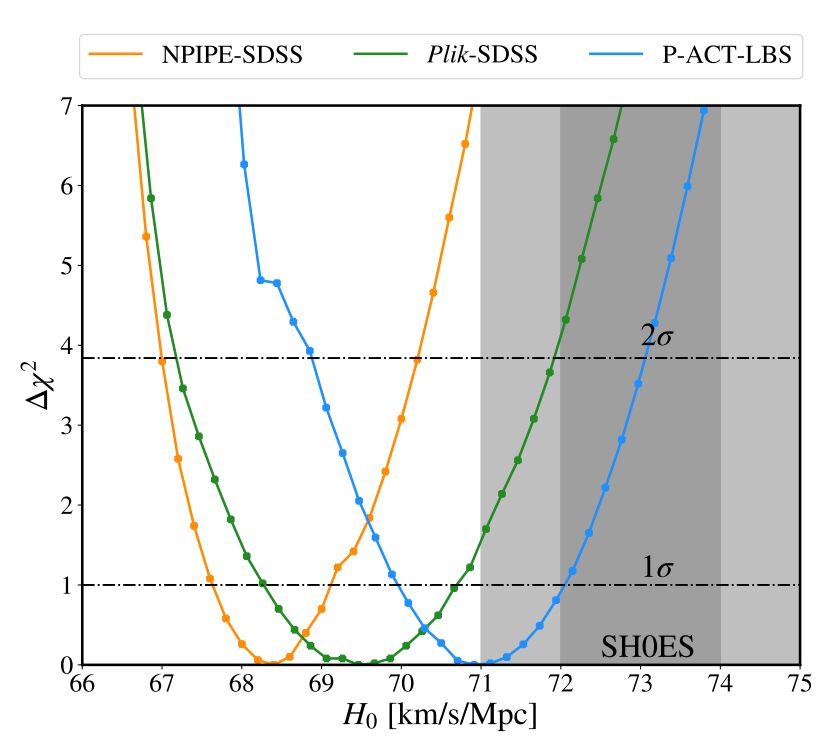
The most striking difference between NPIPE+SDSS and ACT+DESI is seen when computing the profile likelihood of H0 and fEDE. In the ACT+DESI case `PACTLBS' the frequentist CI at 68% are fEDE ~0.09+-0.03 and H0 ~ 71 +- 1. The fit with H0=73 (SH0ES value) is better than with H0 = 68.4 (LCDM value)!
14.05.2025 11:14 — 👍 0 🔁 0 💬 1 📌 0
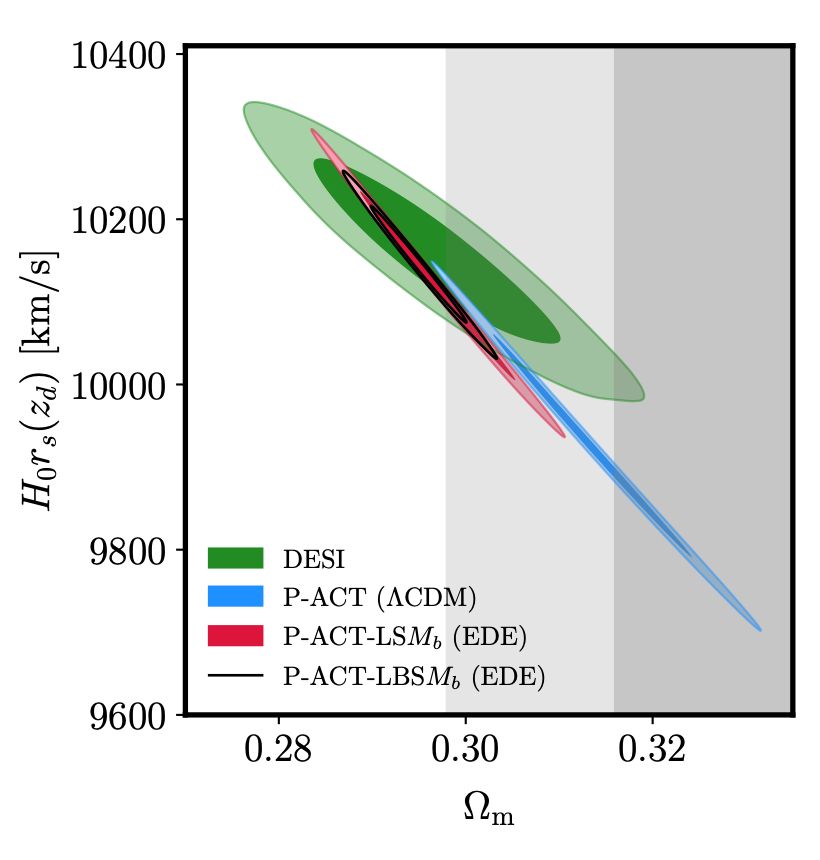
Moreover, we show that EDE rises the value of H0rs and decreases slightly Omega_m, improving consistency between CMB and DESI DR2 data. Including DESI DR2 thus further relaxes the constraints to the EDE contribution (fEDE) and the value of H0. See also Chaussidon++ 2503.24343
14.05.2025 11:14 — 👍 0 🔁 0 💬 1 📌 0
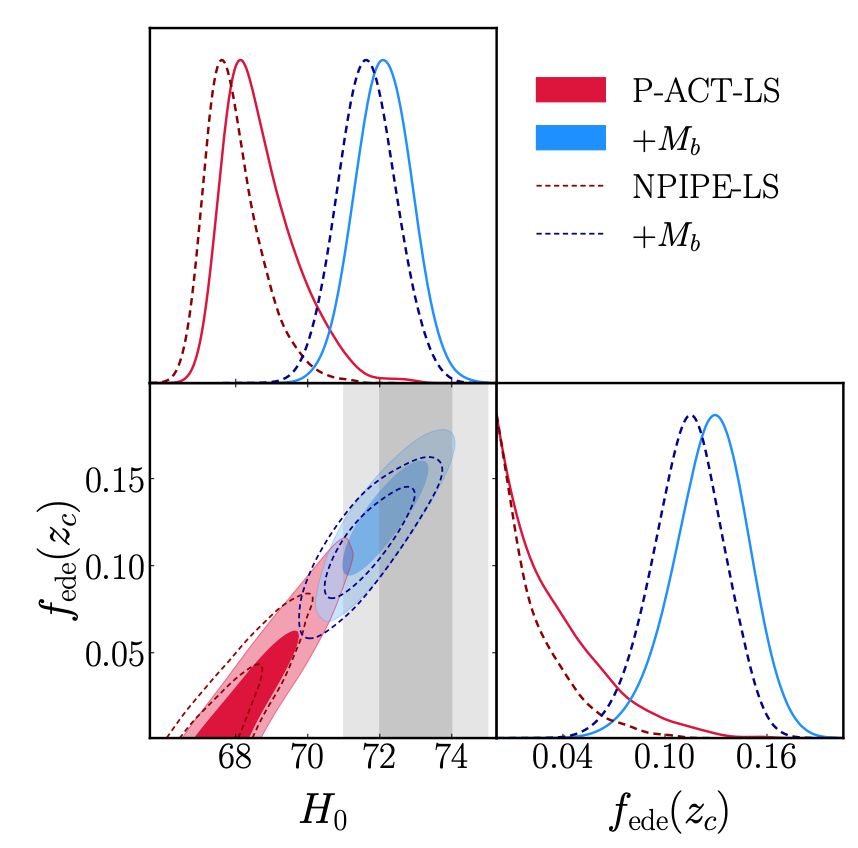
Yet, ACT DR6 and DESI DR2 data are significantly less constraining than Planck NPIPE and SDSS (see Efstathiou et al. 2311.00524) despite increase precision at small angular scales. The residual tension with SH0ES *decreases* from 3.7 sigma to 2sigma (under LCDM, the tension is around 6-6.5sigma).
14.05.2025 11:14 — 👍 0 🔁 0 💬 1 📌 0
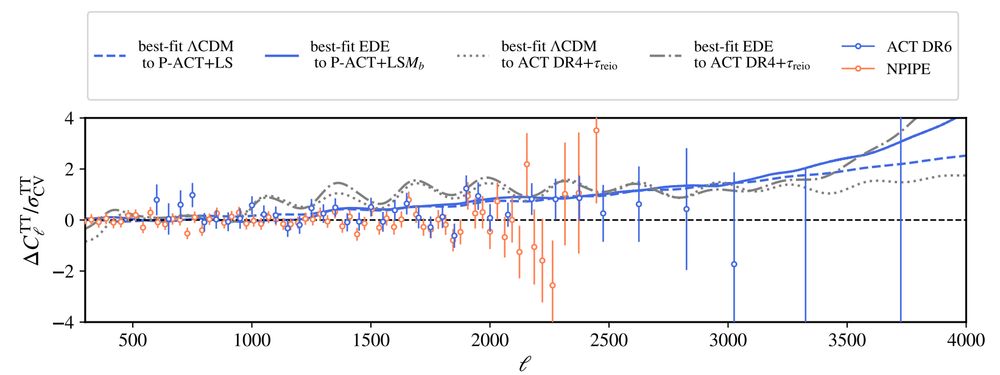
First, we point out that it is not so surprising that the preference for the ACT DR4 favored model did not increase, because the parameters of the model (fEDE of ~25% and H0 ~ 78) were in strong tension with Planck NPIPE. If they had confirm such numbers, it would have led to a large `CMB tension’!
14.05.2025 11:14 — 👍 0 🔁 0 💬 1 📌 0
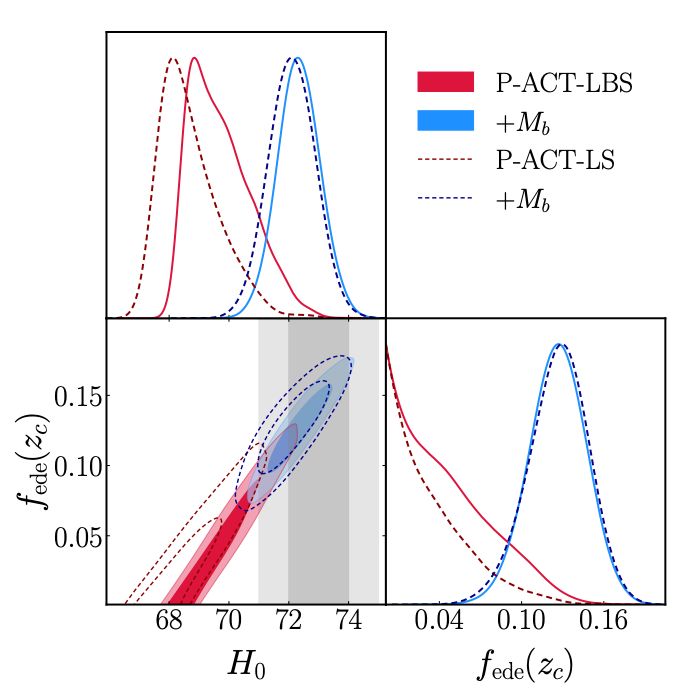
TLDR; contrarily to previous analysis of ACT DR4, the new data do not favor EDE in the Bayesian analysis, only leading to upper limits to the max EDE contribution (fEDE), unless SH0ES is included. However, there are some intriguing aspects that we point out in our paper.
14.05.2025 11:14 — 👍 0 🔁 0 💬 1 📌 0
First of all, our results are in good agreement with those presented by the ACT collaboration in Calabrese et al 2503.14454. The main difference is i) the use of the new DESI BAO DR2 data ii) The comparison of Bayesian and Frequentist constraints on the model iii) the combination with SH0ES data.
14.05.2025 11:14 — 👍 1 🔁 0 💬 1 📌 0
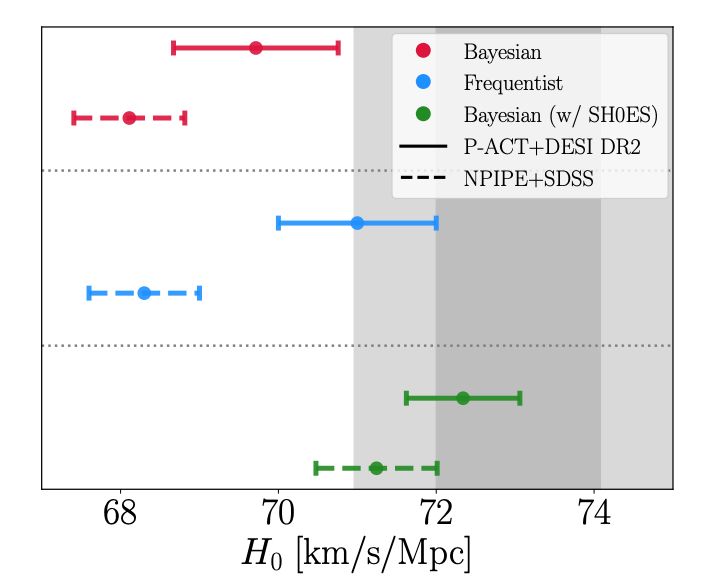
In today’s new preprint arxiv.org/abs/2505.08051, we explore the constraints that the new data release by the ACT and DESI collaboration place on the Early Dark Energy model suggested to resolve the “Hubble tension” between CMB and SN1a determinations of the expansion rate of the universe.
14.05.2025 11:14 — 👍 4 🔁 0 💬 1 📌 2
Regarding CCHP I did see a post from Dan scolnic on the platform-whose-name-we-dont-pronounce saying it actually goes in the direction of sh0es because their data gives good agreement on distances with cepheids. combine everything and panplus you would get high h0. But don't quote me on this xD
19.03.2025 22:16 — 👍 1 🔁 0 💬 0 📌 0
Haha no worries what you said makes sense ! ;) I just think that, had we not seen such a huge signal with DR4, we would think that going from planck to planck+actdr6 the situation is better. But that's not what happened and the signal did go down from dr4 to dr6 so it is what it is. Just annoying!
19.03.2025 22:12 — 👍 1 🔁 0 💬 1 📌 0
Now the most statistically constraining dataset they presented, planck+act, yields significantly weaker constraints and close to no tension with sh0es under EDE, me etc. I think that's encouraging, though I understand your view point of course. It would have been great to see a > signal w/ new data
19.03.2025 22:05 — 👍 0 🔁 0 💬 0 📌 0
You're right of course! I think its just that given Planck+ SPT results it would have been really weird that their data yield a preference for such large fraction of EDE as they had seen before. It would likely have created big tensions with other cmb data.
19.03.2025 22:02 — 👍 1 🔁 0 💬 2 📌 0
We're all just super excited 😄
19.03.2025 21:59 — 👍 1 🔁 0 💬 0 📌 0
I think that's DES (dark energy survey) not DESI (dark energy spectroscopic instrument). DESI data are about to come out on the arxiv! Literally tonight. Should confirm what DES suggests too. And also that humans are maximally boring at choosing names of experiment!
19.03.2025 21:45 — 👍 7 🔁 0 💬 0 📌 0
The optimistic view is that we are trending towards one of those early time solutions when adding more accurate highell data. But not sensitive enough yet. The pessimistic one is everything was a fluke, constraints are weaker because its a fluke, and they will get stronger in the future. Could be...
18.03.2025 22:00 — 👍 0 🔁 0 💬 0 📌 0
I dont think that's fully true. The constraints they get combining with planck are significantly *weaker* than those from planck alone. By like 50%. And their bestfit (not the mean) is H0~71.2.
Also they removed their data at ell ~500 that was pulling EDE up in DR4... not sure why likely systematic.
18.03.2025 21:54 — 👍 0 🔁 0 💬 2 📌 0
Husband and father. Proudly serving as Illinois’ 43rd governor.
You know... the weird one.
The Baltimore Orioles are a Major League Baseball team based in Baltimore, Maryland. Known for their rich history, passionate fanbase, and iconic Camden Yards stadium, they compete in the American League East Division.
Democratic Nominee for Mayor of NYC. Assemblymember. Running to make this city affordable. Democratic Socialist. Early Voting: 10/25 - 11/2. Election Day: 11/4. zohranfornyc.com
Dad, husband, teacher, coach, veteran. Governor of Minnesota. Working to move our state forward as #OneMinnesota.
CERN is the European laboratory for particle physics, home to the Large Hadron Collider.
linktr.ee/CERN_official
Commanders/NFL reporter | Substack - Last Man Standig |Prior stop - The Athletic | Pod: Last Man Standig | @team980 | Armed with hoops opinions | Rockin' & Rollin' & whatnot
Senior national columnist for The Athletic. Author; current book, The Why Is Everything, available everywhere: https://www.amazon.com/dp/1324093609/ref=cm_sw_su_dp
Partner, Backstage Media. Past: NFL Network, Sports Illustrated, Yahoo! Sports, SF Chronicle
Minnesota Vikings beat writer @TheAthletic. Hosting Vikes pod, @AlecLewisShow. Mizzou alum from ‘Bama. alewis@theathletic.com. Let the kids write.
NFL | CFB | Rev Share/NIL Projections | Sports Optimization | The Game Isn't Played on a Spreadsheet | @TheAthletic
SrWriter @TheAthleticFS | Ranking 🧙🏼♂️ | #BanKickers & DuckTales for life | Your boos mean nothing | Susan Lucci of Fantasy Sports | @FLEX_Leagues Prez | ✝
Manager & Editor-In-Chief of Blogging The Boys covering the Dallas Cowboys for SB Nation丨Cronkite ASU | Husband, Dad, Son | God Bless
NFL, F1 and more at SBNation.com
https://www.sbnation.com/authors/mark-schofield
Washington Commanders reporter at The Washington Post. Creator of the "Between the Lines" podcast. Mizzou and SJI alum. STL's own. Email: tashanreed1996@gmail.com
Senior editor, NFL (Bears, Chiefs) at The Athletic. Longtime Chicago Tribune sports guy. Living the Northwest Indiana life.
Senior writer at The Athletic. NFL Draft analyst. Flint born, Millington Cardinal. 🎙️Welcome to Detroit. 📚 The Program: Michigan | Mountaintop
Husband & Father | Podcasts: Locked On Bills, Locked On NFL Scouting & NFL First Read | Author: Go Bills! & Buffalo's Run | Substack: Herd Mentality
Cover the Saints at NewOrleans.Football





